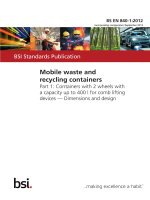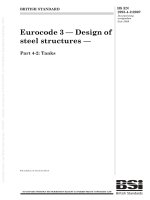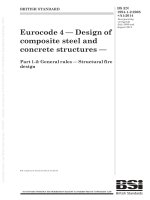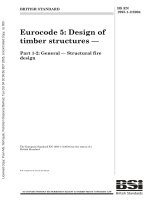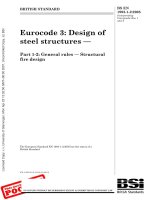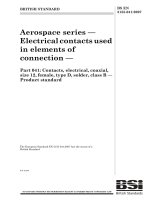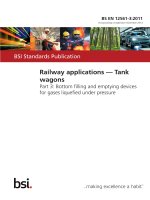Bsi bs en 61753 041 2 2014
Bạn đang xem bản rút gọn của tài liệu. Xem và tải ngay bản đầy đủ của tài liệu tại đây (1.24 MB, 24 trang )
BS EN 61753-041-2:2014
BSI Standards Publication
Fibre optic interconnecting
devices and passive
components — Performance
standard
Part 041-2: Non-connectorized single-mode
OTDR reflecting device for category C —
Controlled environment
BRITISH STANDARD
BS EN 61753-041-2:2014
National foreword
This British Standard is the UK implementation of EN 61753-041-2:2014. It
is identical to IEC 61753-041-2:2014.
The UK participation in its preparation was entrusted by Technical
Committee GEL/86, Fibre optics, to Subcommittee GEL/86/2, Fibre optic
interconnecting devices and passive components.
A list of organizations represented on this committee can be obtained on
request to its secretary.
This publication does not purport to include all the necessary provisions of
a contract. Users are responsible for its correct application.
© The British Standards Institution 2014.
Published by BSI Standards Limited 2014
ISBN 978 0 580 75074 8
ICS 33.180.20
Compliance with a British Standard cannot confer immunity from
legal obligations.
This British Standard was published under the authority of the
Standards Policy and Strategy Committee on 31 August 2014.
Amendments/corrigenda issued since publication
Date
Text affected
BS EN 61753-041-2:2014
EUROPEAN STANDARD
EN 61753-041-2
NORME EUROPÉENNE
EUROPÄISCHE NORM
July 2014
ICS 33.180.20
English Version
Fibre optic interconnecting devices and passive components Performance standard - Part 041-2: Non-connectorized singlemode OTDR reflecting device for category C - Controlled
environment
(IEC 61753-041-2:2014)
Dispositifs d'interconnexion et composants passifs à fibres
optiques - Norme de performance - Partie 041-2: Dispositifs
de réflexion pour OTDR unimodaux non-connectorisés pour
la catégorie C - Environnements contrôlés
(CEI 61753-041-2:2014)
Lichtwellenleiter - Verbindungselemente und passive
Bauteile - Betriebsverhalten - Teil 41-2: Nicht mit
Steckverbindern versehene Einmoden - OTDR Reflektorbauteile für die Kategorie C - Kontrollierte
Umgebung
(IEC 61753-041-2:2014)
This European Standard was approved by CENELEC on 2014-06-12. CENELEC members are bound to comply with the CEN/CENELEC
Internal Regulations which stipulate the conditions for giving this European Standard the status of a national standard without any alteration.
Up-to-date lists and bibliographical references concerning such national standards may be obtained on application to the CEN-CENELEC
Management Centre or to any CENELEC member.
This European Standard exists in three official versions (English, French, German). A version in any other language made by translation
under the responsibility of a CENELEC member into its own language and notified to the CEN-CENELEC Management Centre has the
same status as the official versions.
CENELEC members are the national electrotechnical committees of Austria, Belgium, Bulgaria, Croatia, Cyprus, the Czech Republic,
Denmark, Estonia, Finland, Former Yugoslav Republic of Macedonia, France, Germany, Greece, Hungary, Iceland, Ireland, Italy, Latvia,
Lithuania, Luxembourg, Malta, the Netherlands, Norway, Poland, Portugal, Romania, Slovakia, Slovenia, Spain, Sweden, Switzerland,
Turkey and the United Kingdom.
European Committee for Electrotechnical Standardization
Comité Européen de Normalisation Electrotechnique
Europäisches Komitee für Elektrotechnische Normung
CEN-CENELEC Management Centre: Avenue Marnix 17, B-1000 Brussels
© 2014 CENELEC All rights of exploitation in any form and by any means reserved worldwide for CENELEC Members.
Ref. No. EN 61753-041-2:2014 E
BS EN 61753-041-2:2014
EN 61753-041-2:2014
-2-
Foreword
The text of document 86B/3750/FDIS, future edition 1 of IEC 61753-041-2, prepared by SC 86B "Fibre
optic interconnecting devices and passive components" of IEC/TC 86 "Fibre optics" was submitted to
the IEC-CENELEC parallel vote and approved by CENELEC as EN 61753-041-2:2014.
The following dates are fixed:
•
latest date by which the document has
to be implemented at national level by
publication of an identical national
standard or by endorsement
(dop)
2015-03-12
•
latest date by which the national
standards conflicting with the
document have to be withdrawn
(dow)
2017-06-12
Attention is drawn to the possibility that some of the elements of this document may be the subject of
patent rights. CENELEC [and/or CEN] shall not be held responsible for identifying any or all such
patent rights.
Endorsement notice
The text of the International Standard IEC 61753-041-2:2014 was approved by CENELEC as a
European Standard without any modification.
In the official version, for Bibliography, the following notes have to be added for the standards
indicated:
IEC 61753-089-2
NOTE
Harmonised as EN 61753-089-2.
-3-
BS EN 61753-041-2:2014
EN 61753-041-2:2014
Annex ZA
(normative)
Normative references to international publications
with their corresponding European publications
The following documents, in whole or in part, are normatively referenced in this document and are
indispensable for its application. For dated references, only the edition cited applies. For undated
references, the latest edition of the referenced document (including any amendments) applies.
NOTE 1 When an International Publication has been modified by common modifications, indicated by (mod), the relevant
EN/HD applies.
NOTE 2 Up-to-date information on the latest versions of the European Standards listed in this annex is available here:
www.cenelec.eu.
Publication
Year
Title
EN/HD
Year
IEC 60793-2-50
-
EN 60793-2-50
-
IEC 61300-1
-
Optical fibres -- Part 2-50: Product
specifications - Sectional specification for
class B single-mode fibres
Fibre optic interconnecting devices and
passive components - Basic test and
measurement procedures -- Part 1:
General and guidance
Fibre optic interconnecting devices and
passive components - Basic test and
measurement procedures
Fibre optic interconnecting devices and
passive components - Basic test and
measurement procedures -- Part 2-1: Tests
- Vibration (sinusoidal)
Fibre optic interconnecting devices and
passive components - Basic test and
measurement procedures -- Part 2-4: Tests
- Fibre/cable retention
Fibre optic interconnecting devices and
passive components - Basic test and
measurement procedures -- Part 2-9: Tests
- Shock
Fibre optic interconnecting devices and
passive components - Basic test and
measurement procedures -- Part 2-14:
Tests - High optical power
Fibre optic interconnecting devices and
passive components - Basic test and
measurement procedures -- Part 2-17:
Tests - Cold
Fibre optic interconnecting devices and
passive components - Basic test and
measurement procedures -- Part 2-18:
Tests - Dry heat - High temperature
endurance
Fibre optic interconnecting devices and
passive components - Basic test and
measurement procedures -- Part 2-19:
Tests - Damp heat (steady state)
EN 61300-1
-
IEC 61300 (series) IEC 61300-2-1
-
IEC 61300-2-4
-
IEC 61300-2-9
-
IEC 61300-2-14
-
IEC 61300-2-17
-
IEC 61300-2-18
-
IEC 61300-2-19
-
EN 61300 (series) EN 61300-2-1
-
EN 61300-2-4
-
EN 61300-2-9
-
EN 61300-2-14
-
EN 61300-2-17
-
EN 61300-2-18
-
EN 61300-2-19
-
BS EN 61753-041-2:2014
EN 61753-041-2:2014
IEC 61300-2-22
-
IEC 61300-2-42
-
IEC 61300-2-42
-
IEC 61300-2-44
-
IEC 61300-3-2
-
IEC 61300-3-7
-
IEC 61753-1
2007
IEC 62074-1
-
-4-
Basic test and measurement procedures Part 2-22: Tests - Change of temperature
Fibre optic interconnecting devices and
passive components - Basic test and
measurement procedures -- Part 2-42:
Tests - Static side load for strain relief
Fibre optic interconnecting devices and
passive components - Basic test and
measurement procedures -- Part 2-42:
Tests - Static side load for strain relief
Fibre optic interconnecting devices and
passive components - Basic test and
measurement procedures -- Part 2-44:
Tests - Flexing of the strain relief of fibre
optic devices
Fibre optic interconnecting devices and
passive components - Basic test and
measurement procedures -- Part 3-2:
Examinations
and
measurements
Polarization dependent loss in a singlemode fibre optic device
Fibre optic interconnecting devices and
passive components - Basic test and
measurement procedures -- Part 3-7:
Examinations
and
measurements
Wavelength dependence of attenuation
and return loss of single mode components
Fibre optic interconnecting devices and
passive components performance standard
-- Part 1: General and guidance for
performance standards
Fibre optic interconnecting devices and
passive components - Fibre optic WDM
devices -- Part 1: Generic specification
-
-
EN 61300-2-42
-
EN 61300-2-42
-
EN 61300-2-44
-
EN 61300-3-2
-
EN 61300-3-7
-
EN 61753-1
2007
EN 62074-1
-
–2–
BS EN 61753-041-2:2014
IEC 61753-041-2:2014 © IEC 2014
CONTENTS
1
Scope .............................................................................................................................. 5
2
Normative references ...................................................................................................... 5
3
Terms, definitions and abbreviations ............................................................................... 6
3.1
Terms and definitions.............................................................................................. 6
3.2
Abbreviations .......................................................................................................... 6
4
Test ................................................................................................................................. 7
5
Test report ....................................................................................................................... 7
6
Performance requirements .............................................................................................. 7
6.1
6.2
6.3
6.4
Annex A
Reference components ........................................................................................... 7
Dimensions ............................................................................................................. 8
Sample size ............................................................................................................ 8
Test details and requirements ................................................................................. 8
(normative) Sample size ........................................................................................ 13
Annex B (informative) General information for OTDR reflecting device ................................. 14
Bibliography .......................................................................................................................... 18
Figure B.1 – Functional principle of an OTDR reflecting device ............................................. 14
Figure B.2 – Example for OTDR monitoring using connector as coating support ................... 14
Figure B.3 – Example for OTDR monitoring using NWBD ...................................................... 15
Figure B.4 – Example for OTDR monitoring using WDM ........................................................ 15
Figure B.5 – Example for OTDR monitoring using FBG ......................................................... 15
Figure B.6 – Example for OTDR monitoring using collimator based TFF ............................... 16
Figure B.7 – Example for OTDR monitoring using waveguides and TFF ................................ 16
Figure B.8 – Example for OTDR monitoring using direct coupled TFF ................................... 16
Figure B.9 – Example of the integration of OTDR monitoring for a PTP network .................... 17
Figure B.10 – Example of the integration of OTDR monitoring for a PTMP network ............... 17
Table 1 – Test details and requirements (1 of 5) ..................................................................... 8
Table A.1 – Sample size ....................................................................................................... 13
BS EN 61753-041-2:2014
IEC 61753-041-2:2014 © IEC 2014
–5–
FIBRE OPTIC INTERCONNECTING
DEVICES AND PASSIVE COMPONENTS –
PERFORMANCE STANDARD –
Part 041-2: Non-connectorized single-mode OTDR
reflecting device for category C –
Controlled environment
1
Scope
This part of IEC 61753 contains the minimum initial performance, test and measurement
requirements and severities which a fibre optic non-connectorized OTDR reflecting device for
monitoring point to point (PTP) or point to multipoint (PTMP) passive optical networks (PON)
using an optical time-domain reflectometer (OTDR) should satisfy in order to be categorized
as meeting the requirements of category C (controlled environments), as defined in Annex A
of IEC 61753-1:2007.
2
Normative references
The following documents, in whole or in part, are normatively referenced in this document and
are indispensable for its application. For dated references, only the edition cited applies. For
undated references, the latest edition of the referenced document (including any
amendments) applies.
IEC 60793-2-50, Optical fibres – Part 2-50: Product specifications – Sectional specification for
class B single-mode fibres
IEC 61300 (all parts), Fibre optic interconnecting devices and passive components – Basic
test and measurement procedures
IEC 61300-1, Fibre optic interconnecting devices and passive components – Basic test and
measurement procedures – Part 1: General and guidance
IEC 61300-2-1, Fibre optic interconnecting devices and passive components – Basic test and
measurement procedures – Part 2-1: Tests – Vibration (sinusoidal)
IEC 61300-2-4, Fibre optic interconnecting devices and passive components – Basic test and
measurement procedures – Part 2-4: Tests – Fibre/cable retention
IEC 61300-2-9, Fibre optic interconnecting devices and passive components – Basic test and
measurement procedures – Part 2-9: Tests – Shock
IEC 61300-2-14, Fibre optic interconnecting devices and passive components – Basic test
and measurement procedures – Part 2-14: Tests – High optical power
IEC 61300-2-17, Fibre optic interconnecting devices and passive components – Basic test
and measurement procedures – Part 2-17: Tests – Cold
IEC 61300-2-18, Fibre optic interconnecting devices and passive components – Basic test
and measurement procedures – Part 2-18: Tests – Dry heat – High temperature endurance
–6–
BS EN 61753-041-2:2014
IEC 61753-041-2:2014 © IEC 2014
IEC 61300-2-19, Fibre optic interconnecting devices and passive components – Basic test
and measurement procedures – Part 2-19: Tests – Damp heat (steady state)
IEC 61300-2-22, Fibre optic interconnecting devices and passive components – Basic test
and measurement procedures – Part 2-22: Tests – Change of temperature
IEC 61300-2-42, Fibre optic interconnecting devices and passive components – Basic test
and measurement procedures – Part 2-42: Tests – Static side load for connectors
IEC 61300-2-44, Fibre optic interconnecting devices and passive components – Basic test
and measurement procedures – Part 2-44: Tests – Flexing of the strain relief of fibre optic
devices
IEC 61300-3-2, Fibre optic interconnecting devices and passive components – Basic test and
measurement procedures – Part 3-2: Examination and measurements – Polarization
dependent loss in a single-mode fibre optic device
IEC 61300-3-7, Fibre optic interconnecting devices and passive components – Basic test and
measurement procedures – Part 3-7: Examination and measurements – Wavelength
dependence of attenuation and return loss of single mode components
IEC 61753-1:2007, Fibre optic interconnecting devices and passive components performance
standard – Part 1: General and guidance for performance
IEC 62074-1, Fibre optic WDM devices – Part 1: Generic specification
3
3.1
Terms, definitions and abbreviations
Terms and definitions
For the purposes of this document, the following terms and definitions, as well as those given
in IEC 62074-1, apply.
3.1.1
OTDR reflecting device
wavelength-selective reflecting device having two ports that light from the signal wavelength
ranges transmits from the first port to the second port and OTDR light from the OTDR
wavelength range launched into one port is (partly) reflected back to that launch port
Note 1 to entry:
device.
Annex B of this standard provides information concerning the function of the OTDR reflecting
3.1.2
Type A of OTDR reflecting device
OTDR reflecting device with low attenuation
Note 1 to entry:
Examples are shown in Figures B.2, B.5, B.6, B.7 and B.8 of Annex B.
3.1.3
Type B of OTDR reflecting device
OTDR reflecting device with higher attenuation
Note 1 to entry:
3.2
Examples are shown in Figures B.3 and B.4 of Annex B.
Abbreviations
Abbreviations in order of appearance:
OTDR:
Optical time-domain reflectometer
BS EN 61753-041-2:2014
IEC 61753-041-2:2014 © IEC 2014
–7–
PTP:
Point to point
PTMP:
Point to multipoint
PON:
Passive optical network
GPON:
Gigabit-capable passive optical network
PMD:
Physical media dependent
CSMA:
Carrier sense multiple access
CD:
Collision detection
CO:
Central office
NWBD:
Non-wavelength-selective branching device
HRD:
High reflection device
WDM:
Wavelength division multiplexer
FBG:
Fibre bragg grating
TFF:
Thin film filter
4
Test
Unless otherwise specified, all test methods are in accordance with the IEC 61300 series.
Each test defines the number of samples to be evaluated. The samples used for each test are
intended to be previously unstressed new samples but may also be selected from previously
used samples if desired. The samples shall be terminated onto single-mode fibres as per
IEC 60793-2-50 category B 1.1, B 1.3 or B 6 in either coated fibres (primary and secondary)
or reinforced cable format. All measurements shall be carried out at atmosphere conditions
defined in IEC 61300-1, unless otherwise stated.
All tests shall be carried out over the operating wavelength range listed below:
1) Signal wavelength ranges:
1 260 nm to 1 360 nm;
1 480 nm to 1 500 nm;
1 550 nm to 1 560 nm.
2) OTDR wavelength ranges:
1 620 nm to 1 630 nm;
1 645 nm to 1 655 nm;
unless otherwise specified.
NOTE 1 310 nm, 1 490 nm and 1 550 nm are the nominal or centre wavelengths, stated for the ranges 1 260 nm
to 1 360 nm, 1 480 nm to 1 500 nm and 1 550 nm to 1 560 nm as defined in ITU-T Recommendations G.983.3 and
G.984.2 and IEEE 802.3ah-2004.
5
Test report
Fully documented test reports and supporting evidence shall be prepared and be available for
inspection as evidence that the tests have been carried out and complied with.
6
6.1
Performance requirements
Reference components
The testing for these components does not require the use of reference components.
–8–
6.2
BS EN 61753-041-2:2014
IEC 61753-041-2:2014 © IEC 2014
Dimensions
Dimensions shall comply with those given in appropriate manufacturer’s drawings.
6.3
Sample size
Sample sizes for the tests are defined in Annex A.
6.4
Test details and requirements
Table 1 – Test details and requirements (1 of 5)
No.
1
Test
Attenuation
(insertion loss)
IEC 61300-3-7
2
Wavelength
Isolation
Requirement
Type A: ≤ 0,5 dB
Type B: ≤ 1,0 dB
Attenuation (insertion loss) shall be
met over the operating wavelength
range
≥ 20 dB between signal wavelength
ranges and OTDR wavelength range
IEC 61300-3-7
3
Return loss
IEC 61300-3-7
Grade S1: ≥ 26 dB for signal
wavelength range(s) for both input and
output ports and ≤ 10 dB for OTDR
wavelength range for input port only.
Details
Launch patch
cord length:
≥2m
Polarization
state of light
source:
Unpolarized
Launch
conditions:
The wavelength of the
source shall be longer than
cut-off wavelength of the
fibre.
Measurement
uncertainty:
Test results shall be
obtained under measurement uncertainty of
± 0,1 dB
Launch patch
cord length:
≥2m
Polarization
state of light
source:
Unpolarized
Launch
conditions:
The wavelength of the
source shall be longer than
cut-off wavelength of the
fibre
Measurement
uncertainty:
Test results shall be
obtained under
measurement uncertainty
of ± 1 dB
Source type:
Laser diode (LD)
Measurement
uncertainty:
Test results shall be
obtained under
measurement uncertainty of
± 0,05 dB for RL < 0,5 dB,
of ± 0,2 dB for RL < 1,5 dB,
of ± 0,5 dB for RL < 5 dB,
of ± 1 dB for RL ≥ 5 dB.
Other
requirements:
All ports not under test
shall be terminated to avoid
unwanted reflections
contributing to the
measurement
Grade S2: ≥ 26 dB for operating signal
range(s) for both input and output
ports and ≤ 1,5 dB for OTDR
wavelength range for input port only.
Grade T1: ≥ 35 dB for signal
wavelength range(s) for both input and
output ports and ≤ 5 dB for OTDR
wavelength range for input port only.
Grade T2: ≥ 35 dB for signal
wavelength range(s) for both input and
output ports and ≤ 0,5 dB for OTDR
wavelength range for input port only
BS EN 61753-041-2:2014
IEC 61753-041-2:2014 © IEC 2014
–9–
Table 1 (2 of 5)
No.
4
Test
Polarization
dependent loss
(PDL)
IEC 61300-3-2
5
High optical power
IEC 61300-2-14
Requirement
≤ 0,2 dB
Polarization dependent loss shall be
met over the operating wavelength
range
≥ 300mW (sum of power at the
wavelength ranges at the same time)
During and on completion of the test
the insertion loss limits of test No. 1
shall be met
After the test the wavelength isolation
limits of test No. 2 shall be met
During and on completion of the test
the return loss limits of test No. 3 shall
be met
Details
Launch patch
cord length:
≥2m
Source type:
Laser diode (LD)
Test
wavelengths:
1 310 nm ± 20 nm
Measurement
uncertainty:
Test results shall be
obtained under
measurement uncertainty
of ± 0,05 dB
Source type
Laser diode (LD)
Max. power to
be applied at
wavelength
ranges
1 550 nm to
1 560 nm and
1 620 nm to
1 630 nm
(1 645 nm to
1 655 nm):
300 mW (+ ~25 dBm)
Max. power to
be applied at
wavelength
ranges
1 480 nm to
1 500 nm and
1 260 nm to
1 360 nm:
10 mW (+ 10 dBm)
Measurement
uncertainty:
Test results shall be
obtained under insertion
loss measurement
uncertainty of ± 0,1 dB.
1 550 nm ± 20 nm
Test results shall be
obtained under return loss
measurement uncertainty of
± 0,05 dB for RL < 0,5 dB,
of ± 0,2 dB for RL < 1,5 dB,
of ± 0,5 dB for RL < 5 dB,
of ± 1 dB for RL ≥ 5dB
6
Cold
IEC 61300-2-17
After the test the insertion loss limits
of test No. 1 shall be met.
In addition the change of insertion
loss during the test shall be within ±
0,3 dB from the initial value.
After the test the wavelength isolation
limits of test No. 2 shall be met.
During and on completion of the test
the return loss limits of test No. 3 shall
be met
Temperature:
–10 °C ± 2 °C
Duration of the
exposure:
96 h
Maximum
sampling
interval during
the test:
1h
Measurements
required:
Insertion loss shall be
measured before, during
and after the test.
Return loss shall be
measured before, during
and after the test
– 10 –
BS EN 61753-041-2:2014
IEC 61753-041-2:2014 © IEC 2014
Table 1 (3 of 5)
No.
Test
Requirement
7
Dry heat – High
temperature endurance
After the test the insertion loss
limits of test No. 1 shall be met
IEC 61300-2-18
In addition the change of
insertion loss during the test
shall be within ± 0,3 dB from the
initial value
After the test the wavelength
isolation limits of test No. 2 shall
be met
During and on completion of the
test the return loss limits of test
No. 3 shall be met
8
Change of temperature
IEC 61300-2-22
Details
Temperature:
+ 60 °C ± 2 °C
Duration of the
exposure:
96 h
Maximum
sampling
interval during
the test:
1h
Measurements
required:
Insertion loss shall be
measured before, during
and after the test.
Return loss shall be
measured before, during
and after the test
After the test the insertion loss
limits of test No. 1 shall be met
High
temperature:
+ 60 °C ± 2 °C
In addition the change of
insertion loss during the test
shall be within ± 0,3 dB from the
initial value
Low
temperature:
–10 °C ± 2 °C
Number of
cycles:
5
Rate of
temperature
change:
1 °C/min
Duration at
extreme
temperatures:
1h
Maximum
sampling
interval during
the test:
10 min
Measurements
required:
Insertion loss shall be
measured before, during
and after the test.
After the test the wavelength
isolation limits of test No. 2 shall
be met
During and on completion of the
test the return loss limits of test
No. 3 shall be met
Return loss shall be
measured before, during
and after the test
9
Damp heat
(steady state)
After the test the insertion loss
limits of test No. 1 shall be met.
IEC 61300-2-19
In addition the change of
insertion loss during the test
shall be within ± 0,3 dB from the
initial value.
After the test the wavelength
isolation limits of test No. 2 shall
be met.
During and on completion of the
test the return loss limits of test
No. 3 shall be met.
Temperature:
+ 40 °C ± 2 °C
Humidity:
93 % RH + 2 % RH, – 3 %
RH
Duration of the
exposure:
96 h
Maximum
sampling
interval during
the test:
1h
Measurements
required:
Insertion loss shall be
measured before, during
and after the test.
Return loss shall be
measured before, during
and after the test
BS EN 61753-041-2:2014
IEC 61753-041-2:2014 © IEC 2014
– 11 –
Table 1 (4 of 5)
No.
10
Test
Vibration
IEC 61300-2-1
Requirement
Details
After the test the insertion loss
limits of test No. 1 shall be met.
Frequency
range:
10 Hz – 55 Hz
After the test the wavelength
isolation limits of test No. 2 shall
be met.
Constant
vibration
amplitude:
0,75 mm
After the test the return loss
limits of test No. 3 shall be met
Number of
cycles
15
(10 Hz – 55 Hz
-10 Hz):
Frequency
change:
1 octave/min
Number of
axes:
3 orthogonal
Measurements
required:
Insertion loss shall be
measured before and after
the test.
Return loss shall be
measured before and after
the test
11
Shock
IEC 61300-2-9
After the test the insertion loss
limits of test No. 1 shall be met.
Acceleration
force:
5 000 m/s 2
After the test the wavelength
isolation limits of test No. 2 shall
be met.
Number of
axes:
3 main axes, perpendicular
to each other
Duration
shock:
1 ms
Pulse:
Half sine
Number of
shocks:
2 per axis
Measurements
required:
Insertion loss shall be
measured before and after
the test.
After the test the return loss
limits of test No. 3 shall be met
Return loss shall be
measured before and after
the test
12
Fibre/cable retention
IEC 61300-2-4
After the test the insertion loss
limits of test No. 1 shall be met.
Magnitude of
the load:
After the test the wavelength
isolation limits of test No. 2 shall
be met.
After the test the return loss
limits of test No. 3 shall be met
10 N ± 1 N for reinforced
cable.
5,0 N ± 0,5 N for secondary
coated fibre.
2,0 N ± 0,2 N for primary
coated fibre.
Load
application
point:
0,3 m from the end of
device.
Load rate:
5 N/s for reinforced cable.
0,5 N/s for coated fibre.
Duration of the
load:
120 s at 10 N
Measurements
required:
Insertion loss shall be
measured before and after
the test.
60 s at 5 N and 2 N
Return loss shall be
measured before and after
the test
– 12 –
BS EN 61753-041-2:2014
IEC 61753-041-2:2014 © IEC 2014
Table 1 (5 of 5)
No.
13
Test
Flexing of the strain
Relief of fibre optic
devices
IEC 61300-2-44
Requirement
Details
After the test the insertion loss
limits of test No. 1 shall be met.
Magnitude of
the load:
2,0 N ± 0,2 N for reinforced
cable
After the test the wavelength
isolation limits of test No. 2 shall
be met.
Load
application
point:
0,2 m from end of device
After the test the return loss
limits of test No. 3 shall be met
Angle of
direction:
± 90°
Number of
cycles:
30 cycles
Measurements
required:
Insertion loss shall be
measured before and after
the test.
Return loss shall be
measured before and after
the test
14
Static side load for
connectors
After the test the insertion loss
limits of test No. 1 shall be met.
IEC 61300-2-42
After the test the wavelength
isolation limits of test No. 2 shall
be met.
After the test the return loss
limits of test No. 3 shall be met
Magnitude of
the load:
1,0 N ± 0,1 N for reinforced
cable
0,2 N ± 0,02 N for
secondary coated fibres.
Load
application
point:
0,3 m from the end of
device.
Duration of the
load:
1 h at 1 N
Measurements
required:
Insertion loss shall be
measured before and after
the test.
5 min at 0,2 N
Return loss shall be
measured before and after
the test
BS EN 61753-041-2:2014
IEC 61753-041-2:2014 © IEC 2014
– 13 –
Annex A
(normative)
Sample size
All samples shall be subjected to tests 1 – 5. All other tests shall be carried out in any of the
following order. Consecutive testing on the same optical sample is allowed, but in case of
failure during the consecutive testing, a new sample shall be prepared and the failed test shall
be redone.
Table A.1 – Sample size
Test number
Test
Sample size
1
Attenuation (insertion loss)
12
2
Wavelength isolation
12
3
Return loss
12
4
Polarization dependent loss
12
5
High optical power
12
6
Cold
4
7
Dry heat – High temperature endurance
4
8
Damp heat (steady state)
4
9
Change of temperature
4
10
Vibration
4
11
Shock
4
12
Fibre / cable retention
4
13
Flexing of the strain relief of fibre optic devices
4
14
Static side load for connectors
4
– 14 –
BS EN 61753-041-2:2014
IEC 61753-041-2:2014 © IEC 2014
Annex B
(informative)
General information for OTDR reflecting device
OTDRs outside the PON’s working wavelength range are used for physical monitoring of the
network lines. Reflector devices with high reflectance may help to monitor the network lines.
Reflector devices are components with one input and one output port. Figure B.1 shows the
functional principle of such a device.
IEC
1567/14
* Transmission wavelengths shall be operable in both directions.
Figure B.1 – Functional principle of an OTDR reflecting device
The OTDR reflecting devices are used inside the optical network for reflecting the OTDR
signals back to the central office (CO) without disturbances to the traffic signals. The reflector
can be based on different technical solutions:
–
Patch cord or pigtail with one optical connector with wavelength selective coating at the
front surface (Figure B.2). The connector is shown as it provides support for the
wavelength selective coating.
Wavelength
selecting
coating
1 490 nm and 1 550 nm and 1 625 nm
From / to
central office
From / to
customer
1 310 nm and 1 625 nm
Fibre
Connector
IEC
1568/14
Figure B.2 – Example for OTDR monitoring using connector as coating support
–
Unsymmetrical wavelength independent branching device, e.g. with coupling ratio of 10 %,
with wavelength selective reflection coating or reflection device at the low power port
(Figure B.3).
BS EN 61753-041-2:2014
IEC 61753-041-2:2014 © IEC 2014
– 15 –
1 490 nm and 1 550 nm and 1 625 nm
From / to
central office
1 490 nm and 1 550 nm and 1 625 nm
From / to
customer
(90 %)
(10 %)
NWBD
1 310 nm and 1 625 nm
1 310 nm
Fibres
1 490 nm and
1 550 nm and
1 625 nm
HRD
1 625 nm
IEC
1569/14
Figure B.3 – Example for OTDR monitoring using NWBD
–
Wavelength division multiplexer according to IEC 61753-089-2 with reflection coating or
reflection device at the 1 625 nm (1 650 nm) port (Figure B.4).
1 490 nm and 1 550 nm and 1 625 nm
From / to
central office
1 490 nm and 1 550 nm
From / to
customer
WDM
1 310 nm and 1 625 nm
1 310 nm
Fibres
1 625 nm
HRD
1 625 nm
IEC
1570/14
Figure B.4 – Example for OTDR monitoring using WDM
–
Fibre Bragg grating (FBG) designed for the OTDR wavelength (Figure B.5).
1 490 nm and 1 550 nm and 1 625 nm
1 490 nm and 1 550 nm
From / to
central office
From / to
customer
1 310 nm and 1 625 nm
1 310 nm
Fibre with FBG
IEC
Figure B.5 – Example for OTDR monitoring using FBG
1571/14
BS EN 61753-041-2:2014
IEC 61753-041-2:2014 © IEC 2014
– 16 –
–
Thin film filter based device using classic design based on collimators (Figure B.6).
TFF
1 490 nm and 1 550 nm and 1 625 nm
1 490 nm and 1 550 nm
From / to
central office
From / to
customer
1 310 nm and 1 625 nm
1 310 nm
Fibre
Collimators
Fibre
IEC
1572/14
Figure B.6 – Example for OTDR monitoring using collimator based TFF
–
Thin film filter based device using optical waveguides (Figure B.7)
TFF
1 490 nm and 1 550 nm and 1 625 nm
1 490 nm and 1 550 nm
From / to
central office
From / to
customer
1 310 nm and 1 625 nm
Fibre
1 310 nm
Planar waveguides
Fibre
IEC
1573/14
Figure B.7 – Example for OTDR monitoring using waveguides and TFF
–
Direct coupled thin film filter based device (Figure B.8).
TFF
1 490 nm and 1 550 nm and 1 625 nm
1 490 nm and 1 550 nm
From / to
central office
From / to
customer
1 310 nm and 1 625 nm
Fibre
Fibres
Fibre
1 310 nm
IEC
1574/14
Figure B.8 – Example for OTDR monitoring using direct coupled TFF
All solutions are suitable for monitoring PTP optical networks (Figure B.9) and as well as for
monitoring PTMP optical networks (Figure B.10). Additionally all solutions are suitable for
monitoring optical networks with one and with two fibres.
BS EN 61753-041-2:2014
IEC 61753-041-2:2014 © IEC 2014
– 17 –
IEC
1575/14
Figure B.9 – Example of the integration of OTDR monitoring for a PTP network
IEC
1576/14
Figure B.10 – Example of the integration of OTDR monitoring for a PTMP network
– 18 –
BS EN 61753-041-2:2014
IEC 61753-041-2:2014 © IEC 2014
Bibliography
IEC 61753-089-2, Fibre optic interconnecting devices and passive components – Performance
standard
– Part 089-2: Non-connectorized single-mode bidirectional OTDR monitoring
WWDM devices for category C – Controlled environment
ITU-T Recommendation G.671 – Transmission characteristics of optical components and
subsystems
ITU-T Recommendation L.41 – Maintenance wavelength on fibres carrying signals
ITU-T Recommendation L.66 – Optical fibre cable maintenance criteria for in-service fibre
testing in access networks
ITU-T Recommendation G.983.3 – A broadband optical access system with increased service
capability by wavelength allocation
ITU-T Recommendation G.984.2 – Gigabit-capable Passive Optical Networks (GPON),
Physical Media Dependent (PMD) layer specification
IEEE 802.3ah.-2004 – IEEE Standard for Information technology – Telecommunications and
information exchange between systems – Local and metropolitan area networks – Specific
requirements – Part 3: Carrier Sense Multiple Access with Collision Detection (CSMA/CD)
Access Method and Physical Layer Specifications
Amendment: Media Access Control Parameters, Physical Layers, and Management
Parameters for Subscriber Access Networks
_____________
This page deliberately left blank
This page deliberately left blank
NO COPYING WITHOUT BSI PERMISSION EXCEPT AS PERMITTED BY COPYRIGHT LAW
British Standards Institution (BSI)
BSI is the national body responsible for preparing British Standards and other
standards-related publications, information and services.
BSI is incorporated by Royal Charter. British Standards and other standardization
products are published by BSI Standards Limited.
About us
Revisions
We bring together business, industry, government, consumers, innovators
and others to shape their combined experience and expertise into standards
-based solutions.
Our British Standards and other publications are updated by amendment or revision.
The knowledge embodied in our standards has been carefully assembled in
a dependable format and refined through our open consultation process.
Organizations of all sizes and across all sectors choose standards to help
them achieve their goals.
Information on standards
We can provide you with the knowledge that your organization needs
to succeed. Find out more about British Standards by visiting our website at
bsigroup.com/standards or contacting our Customer Services team or
Knowledge Centre.
Buying standards
You can buy and download PDF versions of BSI publications, including British
and adopted European and international standards, through our website at
bsigroup.com/shop, where hard copies can also be purchased.
If you need international and foreign standards from other Standards Development
Organizations, hard copies can be ordered from our Customer Services team.
Subscriptions
Our range of subscription services are designed to make using standards
easier for you. For further information on our subscription products go to
bsigroup.com/subscriptions.
With British Standards Online (BSOL) you’ll have instant access to over 55,000
British and adopted European and international standards from your desktop.
It’s available 24/7 and is refreshed daily so you’ll always be up to date.
You can keep in touch with standards developments and receive substantial
discounts on the purchase price of standards, both in single copy and subscription
format, by becoming a BSI Subscribing Member.
PLUS is an updating service exclusive to BSI Subscribing Members. You will
automatically receive the latest hard copy of your standards when they’re
revised or replaced.
To find out more about becoming a BSI Subscribing Member and the benefits
of membership, please visit bsigroup.com/shop.
With a Multi-User Network Licence (MUNL) you are able to host standards
publications on your intranet. Licences can cover as few or as many users as you
wish. With updates supplied as soon as they’re available, you can be sure your
documentation is current. For further information, email
BSI Group Headquarters
389 Chiswick High Road London W4 4AL UK
We continually improve the quality of our products and services to benefit your
business. If you find an inaccuracy or ambiguity within a British Standard or other
BSI publication please inform the Knowledge Centre.
Copyright
All the data, software and documentation set out in all British Standards and
other BSI publications are the property of and copyrighted by BSI, or some person
or entity that owns copyright in the information used (such as the international
standardization bodies) and has formally licensed such information to BSI for
commercial publication and use. Except as permitted under the Copyright, Designs
and Patents Act 1988 no extract may be reproduced, stored in a retrieval system
or transmitted in any form or by any means – electronic, photocopying, recording
or otherwise – without prior written permission from BSI. Details and advice can
be obtained from the Copyright & Licensing Department.
Useful Contacts:
Customer Services
Tel: +44 845 086 9001
Email (orders):
Email (enquiries):
Subscriptions
Tel: +44 845 086 9001
Email:
Knowledge Centre
Tel: +44 20 8996 7004
Email:
Copyright & Licensing
Tel: +44 20 8996 7070
Email:
